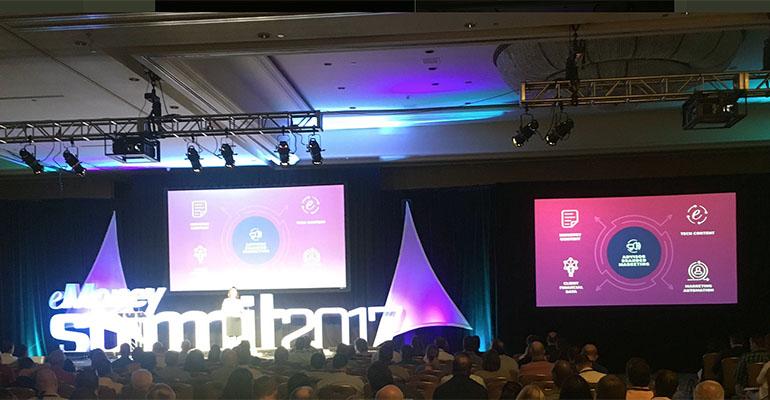Ed O’Brien, chief executive officer of eMoney Advisor, says his company’s “North Star” is creating a platform to deliver “as many plans to as many people as possible.”
To that end, the focus of this year’s eMoney Advisor Summit, which took place this week in Scottsdale, Ariz., wasn’t on new integrations with emX Select, updates to financial planning capabilities or even the compliance tools that took center stage at last year’s summit. Even the digital advice tools developed with in partnership with eMoney’s parent company Fidelity took a back seat to a new initiative from the Radnor, Penn.-based financial planning company, Advisor Branded Marketing (ABM).
The spotlight was on eMoney’s new ABM feature, which provides advisors and firms with a library of more than 2,000 pieces of multimedia content within the eMoney dashboard that can be shared on social media, in client emails or on the advisor’s website. The content comes categorized by topics like charitable giving, consumer protection and estate planning, as well as by client segmentation like generation or investable assets. Everything can be customized including the advisor’s logo and branding.
ABM is equipped with analytics to measure the effectiveness of various marketing campaigns, as well as a process for approving content, making comments and tracking both internally and externally for compliance purposes.
“Advisors want to know what’s resonating with clients,” said Jess Liberi, the senior vice president of product management at eMoney who presented ABM to an audience of about 800 attendees who were given a free three-month trial of the product. The total cost for an annual subscription to ABM will be $1,500. She added that ABM was developed for small, independent advisors as well as large firms and home offices who want to sure that their advisors are conveying a unified message to clients. In the future, firms will have the ability to add their own content.
Several of the Summit’s keynotes also focused on branding. Guy Kawasaki, a marketing specialist and venture capitalist who’s infamous in Silicon Valley for marketing Apple’s Macintosh computer line in the 1980s, provided advisors with tips on how to be “enchanting.” Clara Shih, CEO and co-founder of Hearsay Social, also spoke on how advisors can use social networks to improve client communications.
Liberi said the decision to launch marketing tools within the financial planning platform was driven by the results of a survey of 450 financial advisors. While 98 percent said marketing and client communications was important for growing a business, 86 percent said they needed help with it.
“Today's advisors realize that strategic marketing is vital to the success of their business, but they also admit that they need a little help," said Liberi.
In addition to bringing financial plans to more people, O’Brien added that the client communication tools can improve planning by making sure clients stay engaged.
“What happens a lot of time is advisors and clients think that once they’ve created a plan, that’s it,” O’Brien told WealthManagement.com. “We don’t believe that. We think it’s much more engagement, much more collaboration … it’s helping the clients achieve the goals, not just put them down on paper.”
Liberi also gave a look at eMoney’s focus for 2018, new simplified planning tools to streamline the data-gathering process and make it easier for advisors to offer plans for clients with less complex needs. For example, maybe a young family isn’t worried about retirement yet, and just needs help getting a college savings plan started. The idea is to bridge the gap between digital, self-guided clients and eMoney’s more advanced planning features to, once again, “provide more plans to more people.”





